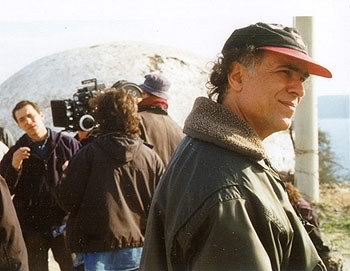Bringing Osho to the Big Screen
by Swami Veet Lakshen

Swami Veet Lakshen is Italian and has been a sannyasin since 1978. He recently visited us at Viha. He is a filmmaker, and his current “mission” is to make a feature film about Osho.
I was born and grew up in the same town as Fellini, so maybe this is one of the reasons why I decided to become a filmmaker. I’ve never studied at any film school, and I’ve never been a so-called cinephile, but I’ve always felt that I have things to say and I love movies. So at a certain time in my life I went to Rome, the center of the Italian film business. After getting to know several people, including Bertolucci’s executive producer, I applied for a special grant that the Italian Ministry of Culture gives to newcomers to the industry, and in a very Gurdijeffian way I got it! That’s how I produced my first 35mm feature film, Blue Line.
Blue Line is a love story that happens all in one night, in my home town of Rimini. It is about a photographer who was born in the city (but is now living in Paris) and who comes back after many years to attend the wedding of an old school friend to a fresh, young girl. The photographer and the girl escape from the “Fellinesque” wedding, and she takes him around the city. Through reviving memories of his past and his encounters with the new generations, the photographer opens up his heart again. The surprise comes at the end, when he wakes up on the train from Paris, just a few minutes before reaching Rimini. It seems that it was all a dream! But at the train station he sees some people he met in the “dream,” and also the girl...as if the distinction between dream and reality is not that big.
The film was selected for the prestigious International Film Festival in Venezia in 1995, and later on it won the Quality Prize from the Italian Ministry’s Council.
A few years later I wrote, directed, and produced my second feature film, Zorba Il Buddha. The film featured one of the best-known sannyasin kids of Pune One: “little” Siddhartha. The movie is the story of a young disk jockey involved with sex, drugs, and rock ’n’ roll in a kind of modern Zorba lifestyle. The DJ falls in love with a mystical sailor woman who is traveling around the world on her boat, carrying a precious statue of Buddha.
Through the love story between the two characters I tried to convey Osho’s vision of the complementary of the opposites, and for the first time in feature-film history Dynamic Meditation was shown on the screen. There were many aspects to the creative process involved in making the film. When I worked with the actors, I used meditation and some forms of therapy, like Family Constellation. I also adapted that technique in order to help the actors experience the relationships within the group.
I think the scene of Dynamic Meditation is one of the best in the movie, and even people who don’t particularly like the film remember that scene very vividly. One interesting note is that when sannyasins watch the scene they tend to laugh. I notice how different it is to approach the movie with the eyes of a sannyasin, or with the eyes of one who knows nothing about sannyas. And actually, my goal in making the movie was to present these things to people who don’t know much about them – especially the young generation.
The film had an independent distribution in Italian theaters and was presented at several film festivals around the world, plus on Sky TV. I think the critics were split in two about this movie; some understood the meaning of the film and some did not. Anyway, my experience in making this kind of very independent movie is that you either become a sort of “cult” director or you are totally ignored by the mainstream market. And it’s much easier to remain in the first category, whether the film is good or not!
Now I have embarked on another exciting, but not-so-easy project: making a real feature film about Osho. I have written a script about a female journalist who goes to the Ranch one week before our Master was arrested. She goes there with all the skeptical attitudes a journalist can have, but slowly, slowly she starts to feel sympathetic toward the Master. Although she never becomes a sannyasin (otherwise it would look like a propaganda film) she questions herself and the audience about all the reasons behind the persecution of Osho. The story will also include flashbacks to Osho’s childhood, which are taken from a book the journalist reads during her experience at the Ranch.
The film has two aims. One is to let the world know what happened to Osho in the United States, in a sort of “open case” format, like Oliver Stone’s movie JFK. In that movie there is no actor playing Kennedy, and I am also thinking to use real footage, with no actor playing Osho. The second aim of the film is to show the mystical, poetic, and outrageous childhood of our beloved Master that later led Him to enlightenment.
At the moment I am traveling around the world, making contact with producers and private investors in America, India, and Europe in order to secure the financing, and I hope to start shooting soon. I am trying to find mainstream production and distribution for the movie, and the challenge is to get it without compromising any of what I want to say about Him.
If anybody feels to contribute or wants to have more information, you can write to me at sucameli@libero.it.